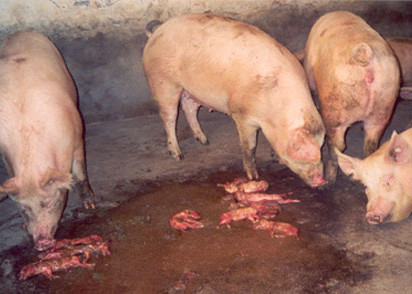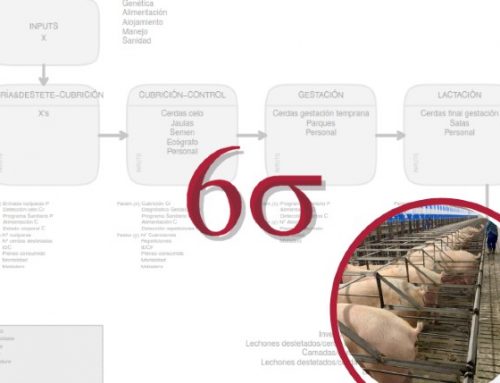Seasonal abortions in sows. Causes and prevention.
Early abortions in sows are caused by several factors and must be under control, especially in seasonal times when the number of fetal deaths increases considerably.
In the pork industry, abortions occur mainly in autumn and have, therefore, the worsening of their well-being, as well as significant economic loss for the farms.
Seasonal abortions are also typical during spring (on facilities with outdoor yards as the sun burns the sows’ skin).
Seasonal abortions occur mainly in autumn due to “the change in the photoperiod that influences the maintenance of gestation together with a poorer body condition of the sow at weaning and the beginning of somewhat colder nights. The most common months for this to occur in the northern hemisphere are September, October, and November. To counteract this type of gestation loss it is necessary to ensure that the hours of light (minimum 14 h) and intensity (min. 250-300 lux) are maintained, while at the same time ensuring a feed intake approximately 30% higher than the maintenance needs, and if possible, having a boar presence daily to maintain higher levels of progesterone.” (Marco, Enric. 2020).

Source: 3tres3
Abortions and micro-abortions in sows
Abortions are the intrauterine death of fetuses (also called << fetal deaths >> or << interruption and premature termination of the sow’s gestation >>) with its consequent ejection.
The difference between abortions and micro-abortions is in the gestation period. For the former, the loss of gestation is between days 30 and 110 while for the latter they occur before day 30.
The percent of abortions among serviced sows should never exceed 2% and when this limit is surpassed, it is when we must consider a seasonal problem or bad physical and/or environmental conditions.
Diagnostic and causes of seasonal abortions in sows
Before the 30th day of gestation, there is no bone formation, so it is reabsorbed. Thus, reabsorption occurs from the first week to the third post-mating week with a return to heat.
We begin by defining the problem: When do sows abort? Are abortions occurring above normal levels? In that case … How much? Is it seasonal? What is the incidence pattern? Is there some kind of relation with other variables?
Abortions often cause scaremongering. However, we must bear in mind that during the first days of gestation – before the calcification process – it is possible to have embryonic losses. These are not observed since a reabsorption phenomenon subsequently occurs and they generate a repeated bristle (what we commonly call “cyclical”, “cyclical” or “empty”).
During the second week, hormonal changes are also very common and have a direct impact on gestation. A very notorious effect is the change in the corpus luteum that produces high levels of progesterone and can lead to miscarriage
We must avoid moving the sows in the first 35 – 40 days of gestation, as well as covering sows in a catabolic state (when they have less than 10mm of backfat thickness).
Causes of abortions occurring at a certain point in the sows’ gestation
There are many factors that can provoke abortions, although we can highlight the following:
- High-stress level.
- Unbalanced and nutritionally deficient diets, as well as a shortage of quality water.
- Lack of ventilation, cleaning, and continued disinfection of the gestation shed and facilities.
- Humidity (favoring the proliferation of bacteria) and high temperatures, without also providing spaces with shade at critical times.
- Very short lactations.
- Absence of heat marker male reproductive within the gestation period, whose role is important for mainly increasing the production of progesterone.
- Nulliparous mating at very early ages.
- Physical conditions of the sows in terms of weight.
How to distinguish infections in pregnant sows?
We can categorize two types of infections according to the fetuses’ conditions:
Those with a recent or “fresh” appearance usually indicate abortions due to fever, urogenital infections, or nutritional deficiencies.
When there is the presence of dead fetuses, of different sizes or mummified, among others, there are the following possibilities of viral or bacterial causes:
- Early or spontaneous abortion
- Banal infections: vaginal discharge syndrome, cystitis-nephritis, …
- Systematic infections: Flu, Toxoplasmosis, parasitosis, salmonellosis, mycotoxins, Actinobacillus pleuropneumoniae, and foot infections.
- Porcine Parvovirus
- African Swine Fever
- Classic Swine Fever
- Porcine Reproductive and Respiratory Syndrome (PRRS)
- Leptospirosis: less and less frequent thanks to the new animal welfare regulations.
- or Brucellosis
- Aujeszky’s disease: common in unprotected farms.
- Others are related to the state of the raw material: Mycotoxins, Ergotamine, …
Sow disease symptoms
Some of the symptoms of disease in pregnant sows can be:
- loss of appetite,
- vomiting,
- diarrhea,
- fever,
- cough,
- dyspnea,
- jaundice,
- cystitis,
- hematuria,
- metritis,
- mastitis,
- hypogalactia or agalactia or cyanosis of the extremities (especially in the ears and edge of the udders).
Conclusions
We must always take care of our animals, although we must pay special attention in the critical months that for assignable causes possible to control their well-being is seriously impaired.
To study the causes of abortions, as we have seen, is a prior and complex action. Two interesting articles of how two groups of professionals dealt with this problem and considered multiple indicators to solve it.
References
Marco, E. (2021, 1 abril). Causes of seasonal abortions. 3tres3. https://www.pig333.com/articles/causes-of-seasonal-abortions-in-sows_16740/





